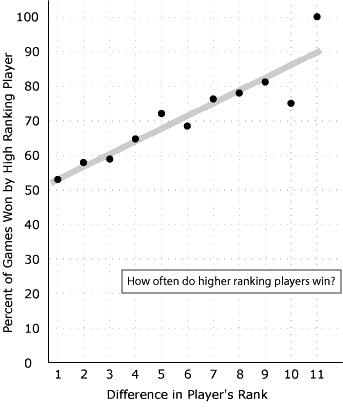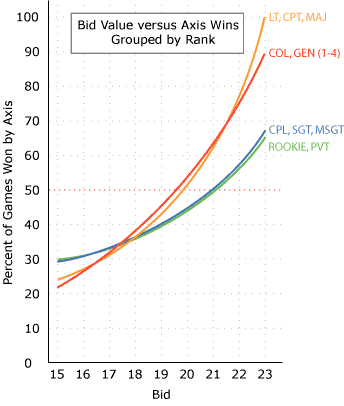More Data is a Good Thing . . . |
||
Fig. 1 |
The graph to the left was published in a Havoc a couple of issues back. It was created from taking the results of 150 games and comparing the ranks of the victors and the vanquished. This lead to the conclusion that if players differ by more than three ranks, the low ranking player has almost no chance of winning. But 150 games is actually a small number when you consider the thousands of games the club has played. A larger set of games will lead to more accurate conclusions . . . |
|
- Behold - |
||
Fig. 2 |
Figure 2 was created from the results of 2605 games, and it looks very different than figure 1. Looking at this new graph you can see that when players differed by 4 ranks, the low ranking player was victorious about a third of the time. So things are not quite as dire for low ranking players as I had lead Havoc readers to believe. I will, from time to time, revisit results and let you know if there are any further corrections or refinements. In that spirit lets look again at "bids and victory". |
|
Bids and VictoryLast time we looked at how many games the Axis won at various bids, I made no attempt to filter the data. This time the data is filtered a bit:• No games which were won by forfeit were considered. • No games involving ROOKIE or PVT players were considered. • Only games over # 5000 were considered. • Bids under 15 or over 23 were not considered This leaves us with 1851 game results which were used to create the glorious Figure 3. Regular Havoc readers won't be surprised by the results. The magic 50/50 point is somewhere in between bids of 20 and 21. But wait there is more . . . |
Fig. 3 |
|
| I divided the ranks into four groups and only looked at games where both players were in the same group. CPT, for example, was placed in a group with LT, and MAJ. So games where a CPT played another CPT (or a LT or a MAJ) were considered, but games where a CPT played a PVT or GEN were not. And so Figure 4 was born. Here we see how the bid effects victory for the four groups. Interestingly the two officer groups are basically the same, and the two enlisted groups are the same, but officers are very different than enlisted players. The bids have a much stronger effect on the officers. I'm going to speculate and say this is because the officers are better able to make every unit count. Fair BidsIf we say a "fair bid" is a bid which gives each player more than 40% chance of winning and less than a 60% chance of winning, then:• For officers a fair bid is from 18 to 21 • For enlisted players a fair bid is from19 to 22 |
Fig. 4 |
|
That's all for now. airship |
||
Back to of page